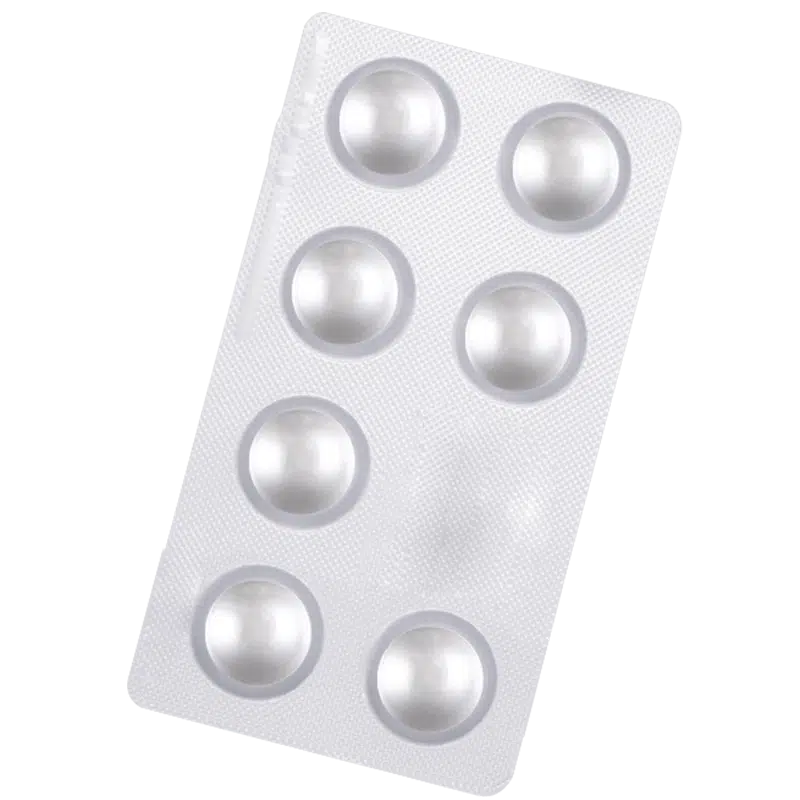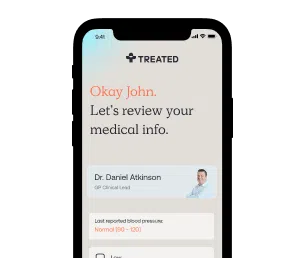Antibiotic tablet for acne and rosacea.


Oxytetracycline is an antibiotic used to treat acne and other skin conditions like rosacea. It comes as a tablet.
We’re here to help you get the treatment that’s best for you. Get expert recommendations from our clinician and order Oxytetracycline online.
Oxytetracycline is a general, broad use antibiotic that’s used to treat a few different infections. You’ll often see it prescribed for common skin infections like acne, as well as rosacea.
Acne is a skin condition that can sometimes be caused by hormonal changes or a large amount of bacteria clogging up your pores. Rosacea is more of a long-term skin condition that goes through periods of remission and flare. If you have rosacea, you’ll get periods where the skin on your face, particularly on your cheeks, becomes red and flushed. It’s not known what causes it.
Oxytetracycline is used to treat acne caused by bacteria and works by killing off bacterial cells, by stopping them from making a self-sustaining protein. It comes as a tablet and will normally be taken once a day for up to three months.
We don’t know a lot about rosacea, but studies have shown that tetracycline antibiotics like Oxytetracycline are effective at treating it when it’s accompanied by acne.
Acne is mostly caused by two things: hormonal imbalances, which is why it is common in teenagers going through puberty and pregnant women; and bacteria. In people with a type of rosacea called acne rosacea, they’ll usually get spots as well as the common flushing and redness across the face.
The pores in your skin produce a chemical called sebum. Sebum works to keep your hair and skin nice and healthy. When your glands overproduce sebum it can block or clog your pores and attract large amounts of bacteria. Although usually harmless, when there’s more of it than usual, this bacteria can cause spots.
Oxytetracycline works by limiting the growth of the bacteria. It does this by stopping the bacteria from making the self-sustaining proteins that it needs to survive. As a result, the bacteria is weakened and killed by your body's immune system.
Oxytetracycline 250mg is the only dose available. If you have a more severe form of acne then the prescriber might recommend you take an increased dose of 500mg. (This will just be two 250mg tablets a day instead of one.)
There are other antibiotics that might work better if Oxytetracycline doesn’t help with your acne. So if your symptoms don’t get better when you’re taking it, let your prescriber know.

How we source info.
When we present you with stats, data, opinion or a consensus, we’ll tell you where this came from. And we’ll only present data as clinically reliable if it’s come from a reputable source, such as a state or government-funded health body, a peer-reviewed medical journal, or a recognised analytics or data body. Read more in our editorial policy.
Your medication should be taken as recommended by your prescriber. Make sure you read the product information leaflet before you use it.
Oxytetracycline is absorbed and starts working in your body quickly. But with most antibiotics that are taken to treat acne and rosacea, like Oxytetracycline, it can take several weeks before you notice the benefits to your skin . If you don’t see any improvements in your condition after three months then our clinician might suggest trying something else.
You should always take your treatment as advised by your prescriber. But, if you do miss a treatment, just make sure you don’t double dose. Take your tablet at the next opportunity and be careful not to exceed your daily dose. Setting alarms or using a reminder app can help you remember to take Oxytetracycline.
One of the most important things to remember taking antibiotics is that your entire course should be taken. Even if your symptoms clear up midway through you should continue with the rest of your medication.

How we source info.
When we present you with stats, data, opinion or a consensus, we’ll tell you where this came from. And we’ll only present data as clinically reliable if it’s come from a reputable source, such as a state or government-funded health body, a peer-reviewed medical journal, or a recognised analytics or data body. Read more in our editorial policy.
Have something specific you want to know? Search our info below, or ask our experts a question if you can’t find what you’re looking for.
Simple
It was easy to discuss and get the correct treatment and it then arrived the next day

Registered with GMC (No. 4624794)
Meet Daniel
Registered with GPhC (No. 2202465)
Meet Sanjeda
Registered with GPhC (No. 2070724)
Meet CraigDelivery, consultation, treatment. It’s all included in the price.
| Quantity | Starting from |
|---|---|
| 112 Tablets | £53.95 |
| Quantity | Starting from |
|---|---|
| 45 g | £51.95 |
| 90 g | £86.95 Save £16.95 |
| Quantity | Starting from |
|---|---|
| 28 Capsules | £30.95 |
| Quantity | Starting from |
|---|---|
| 30 g | £45.95 |
| 60 g | £79.95 Save £11.95 |
| 90 g | £109.95 Save £27.90 |
| Quantity | Starting from |
|---|---|
| 30 g | £45.95 |
| 60 g | £79.95 Save £11.95 |
| 90 g | £109.95 Save £27.90 |
| Quantity | Starting from |
|---|---|
| 28 Tablets | £26.95 |
| Quantity | Starting from |
|---|---|
| 28 Capsules | £35.95 |
| Quantity | Starting from |
|---|---|
| 30 g | £30.95 |
| 60 g | £49.95 Save £11.95 |
| 90 g | £65.95 Save £26.90 |
| Quantity | Starting from |
|---|---|
| 30 g | £43.95 |
| 60 g | £73.95 Save £13.95 |
| 90 g | £101.95 Save £29.90 |
| Quantity | Starting from |
|---|---|
| 30 ml | £41.95 |
| 60 ml | £64.95 Save £18.95 |
| 90 ml | £87.95 Save £37.90 |
We know health, but you know you.
Our experts tell you what’s safe, but you decide what’s best.
Answer a few questions and tell us about yourself. Get tailored advice from our clinicians so you can choose better.

Choose your treatment and how often you have it delivered.

We know things change. It’s the nature of life. We’ll check in regularly to make sure your treatment is still right for you.
Pause. Change. Skip. Start again. Any time you like.
Always arrives on time and I’m kept informed of progress.
I have had it previously from my G.P so It worked as expected, extremely well. My problem is an accessing my G.P practice, they put ED well down their list of priorities. I found your service excellent, quick and efficient. I fully intend to continue using it
Shipping is speedy and the product is amazing.
Fast, slick service. Very easy to amend subscription when required.
All good.
Great service
Really helped me
Trusted service and great service - next day delivery and I can rely on them to send regularly.
Ordering was straight forward, tablets delivered promptly and well packaged, and instructions were clear, thanks.
100% recomended.Great service
Excellent service
Excellent delivery. Can’t fault.
Quick and efficient service, delivered discreetly the next day. Thank you.
Effective
Great service, no wait time
Great
Quick assessing for medicine suitability. Quick delivery and good communication throughout.
Straightforward and quick service!
Good however communication could sometimes be better
Easy and good procedure to get treatment
Excellent product
Excellent service!!! Ordered what I needed sent a picture of my prescription and the parcel arrived the next day!!! Will definitely order again and have recommended to others!!!
Fast shipping
Very quick service all round
So quick and simple. Recommend
Great
Very convenient hassle free service.
Easy to use good communication and fast shipping
Great service
Efficient no issues re delivery
Fabulous service
Brilliant service. Not a bad word to say!
It was fast, professional and it's the right med for what I selected in there.
This review requires content. Oh well..
Great service, quite effortless.
Top notch
Brill service
N/a
Excellent service quick and easy to use
Fast and exact order
Superb service and quick delivery 10/10
Excellent service
Thank you for fast delivery
Shipping is extremely quick and satisfiying
Good stuff
Good service
Great fast delivery
Acne: Here are some other options.
Antibiotic-free treatment available as a cream or gel. Low risk of side effects.
First choice antibiotic treatment. Kills the infection and stops it from multiplying.
Combination treatment that comes in two doses. Easy to use, once a day application.
Versatile treatment for acne, rosacea and skin infections. Available in two strengths.
Strong antibiotic for acne and other skin conditions. Like Tetralysal but cheaper.
Effective antibiotic cream that can also help with scarring.
Once-a-day combination gel that unblocks your pores and tackles acne.
A unique antibiotic and zinc combination that treats your acne and repairs your skin.
We're making healthcare more about you. Sign up to our newsletter for personalised health articles that make a difference.
Disclaimer: The information provided on this page is not a substitute for professional medical advice, diagnosis, or treatment. If you have any questions or concerns about your health, please talk to a doctor.
Interventions for rosacea. The Cochrane Database of Systematic Reviews, p.CD003262.
Potential Role of the Microbiome in Acne: A Comprehensive Review.
We couldn't find what you're looking for.
Here's everything we treat. Or, if you're looking for something we don't have yet, you can suggest something.
If there’s a particular treatment or condition you’re looking for, tell us and we’ll look into it for you.
Submit your question here, or tell us if you’ve found an issue on our site.
We’ll get back to you very soon. We aim to respond to all queries in one working day.
You’re signed up to our newsletter. Keep an eye on your inbox for our latest update.
By clicking 'Subscribe now' you're agreeing to our Privacy Policy.
We’ve sent you an email asking you to confirm your email address.